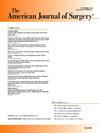如果你建好了,他们就会来——院前全血计划的实施
IF 2.7
3区 医学
Q1 SURGERY
引用次数: 0
摘要
我们试图开发、实施和评估一个城市院前全血(PH-WB)计划。方法利用回顾性热图数据,将携带PH-WB的快速反应车辆(qrv)战略性地部署在全市各地,并采用动态部署的方式进行调度。患者入选标准为年龄≥15岁,创伤机制,收缩压≤90mmhg。前瞻性数据收集于2025年3月21日至6月21日。结果375例患者输注PH-WB 588单位,55%患者输注1单位。输血后,从现场到ED到达,平均收缩压增加28 mmHg,脉搏减少19 bpm。24小时和30天的总生存率分别为83%和80.8%。本研究展示了大规模PH-WB项目的成功实施,利用创造性的策略在有限的资源下覆盖了一个大的集水区。初步结果记录了PH-WB的安全交付,院前现场时间变化最小,现场全血过期率为0%,以及方案的高依从性。本文章由计算机程序翻译,如有差异,请以英文原文为准。
If you build it, they will come - Implementation of a prehospital whole blood program
Introduction
We sought to develop, implement and evaluate an urban prehospital whole blood (PH-WB) program.
Methods
Using retrospective heat map data, Quick Response Vehicles (QRVs) carrying PH-WB were strategically placed throughout the city and dispatched using dynamic deployment. Patient inclusion criteria were age ≥15 years, traumatic mechanism, and SBP ≤90 mmHg. Prospective data were collected between 3/21-6/21/2025.
Results
375 patients were transfused 588 units of PH-WB, with 55 % receiving >1 unit. With transfusion, the average SBP increased by 28 mmHg and pulse decreased by 19 bpm from field to ED arrival. The overall survival at 24-h and 30-days was 83 % and 80.8 %, respectively.
Conclusion
This study demonstrates the successful implementation of large-scale PH-WB program utilizing creative strategies to cover a large catchment zone with limited resources. Preliminary results document safe delivery of PH-WB, minimal variation in pre-hospital scene times, 0 % expiration rate of whole-blood in the field and high compliance with protocols.
求助全文
通过发布文献求助,成功后即可免费获取论文全文。
去求助
来源期刊
CiteScore
5.00
自引率
6.70%
发文量
570
审稿时长
56 days
期刊介绍:
The American Journal of Surgery® is a peer-reviewed journal designed for the general surgeon who performs abdominal, cancer, vascular, head and neck, breast, colorectal, and other forms of surgery. AJS is the official journal of 7 major surgical societies* and publishes their official papers as well as independently submitted clinical studies, editorials, reviews, brief reports, correspondence and book reviews.

 求助内容:
求助内容: 应助结果提醒方式:
应助结果提醒方式:


